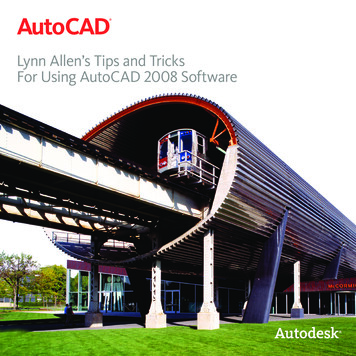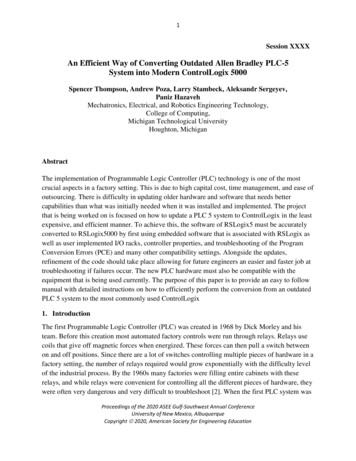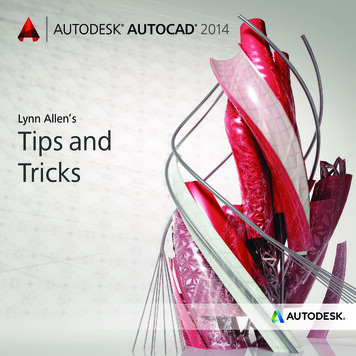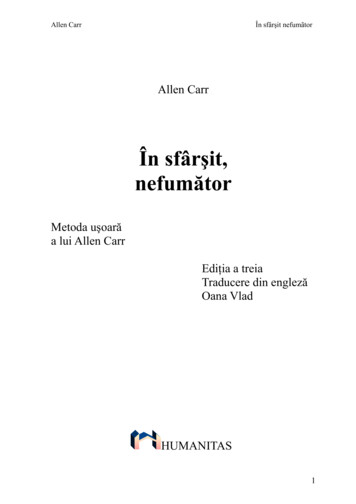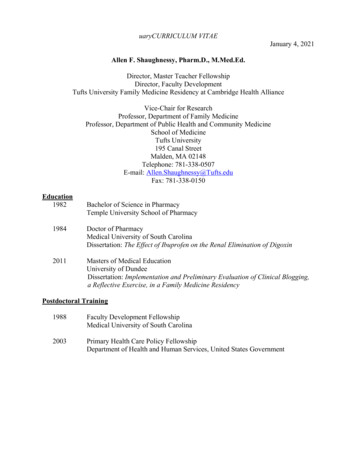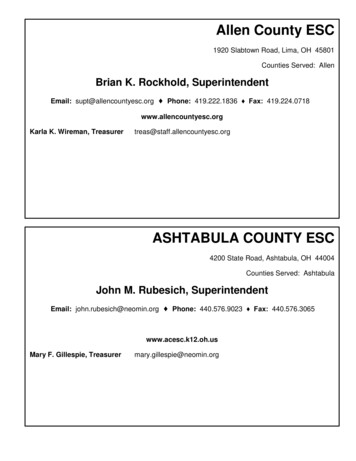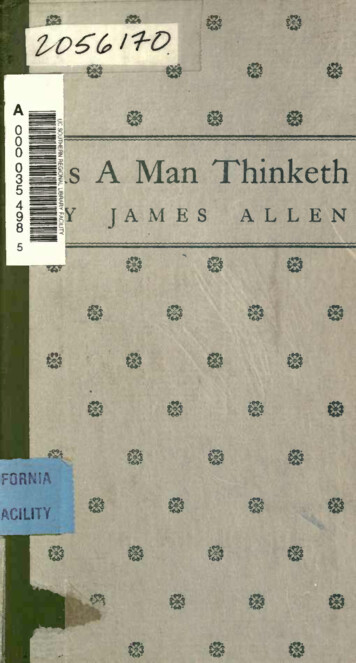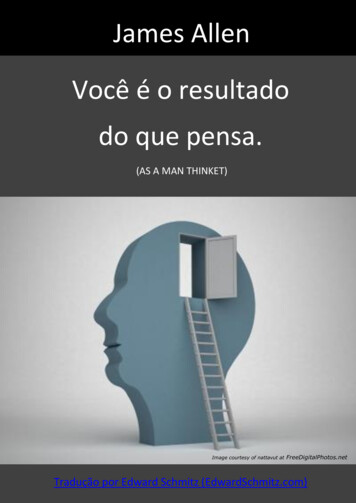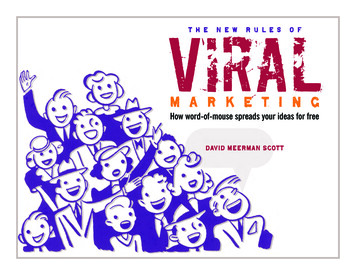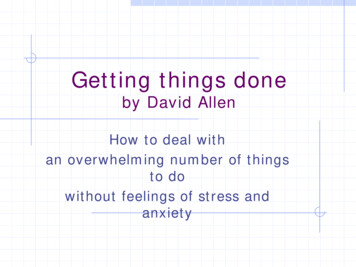
Transcription
Getting things doneby David AllenHow to deal withan overwhelming number of thingsto dowithout feelings of stress andanxiety
“Getting things done”An introduction to GTD ‘GettingThings Done’ Background-Bestselling author, “GettingThings Done”-GTD systemBrent Krueger
Agenda What is GTD ‘Getting things done’? Why are we stressed? To become silent water Some thoughts about the brain and theconsequences of ‘loose ends’ Mastering the workflow Workflow diagram Manage your own projects (vertical dimension) Various ways of implementation References
David Allen“One of the most influential thinkers onproductivity” – Fast Company MagazineYour ability to generate power is directlyproportional to your ability to concentrate.You ability to concentrate is directlyproportional to your ability to eliminatedistractionsDistraction is created by mismanagedcommitments.
Your Mind is for Having Ideas, Notfor Holding Them D. AllenDavid Allen Key concept-Think small. Get the details under control Core principles- Collect, Process, Organize, Review, Do
What is GTD ‘Getting things done’?It’s an Action Management Method – we do notManage Projects or Tasks – we manage actions! A Time Management System Complements our inefficient “Mental ReminderSystem” – clean up all loose end All about horizontal and vertical organization
Do you experience stress from unanswered calls,tasks not delegated,unprocessed issues frommeetings and conversations,personal responsibilitiesundone,e-mails not dealt with, .
Why are we stressed? Perception of having ‘Too much to handle and not thetime to get it all done’- Take on too many commitments- Having too many ideas- Too much involvement- Changing jobs with ever changing Know-how tograsp Too many distractions – no appropriate focus possible Ineffective personal organizational systems creatinghuge subconscious resistance – loose ends
It’s All in Your MindKey elements ControlPerspectiveIncompletes and Open Loops pull atyour attentionIdentify those things that “ring yourbell”
To become silent like waterFirst: Clear your mind byemptying it! Anything youconsider unfinished in any waymust be captured in a trustedsystem outside your mind whereyou come back to regularly andsort through.
To become silent like waterSecond: Clarify exactly whatyour commitment is and decidewhat you have to do, if anything,to make progress toward fulfillingit.
To become silent like waterThird: Once you‘ve decided onall the actions you need to take,you must keep reminders ofthem organized in a systemyou review regularly makeprogress toward fulfilling it.Google Calendar/Tasks
Some thoughts about the brain and the consequencesof ‘loose ends’? Why is our mind not so smart? Do you have a flashlight somewhere with dead batteries in it?When does your mind tend to remind you that you need newbatteries? When you notice the dead ones! That‘s not verysmart. If your mind had any innate intelligence, it would remindyou about those dead batteries only when you passed live onesin a store! Why do you think of stuff you can‘t make progress on? Between the time you woke up today and now, did you think ofanything you needed to do that you still haven‘t done? It‘s a waste of time and energy to keep thinking aboutsomething that you make no progress on. Stuff are open loops – Anything you have allowed into yourpsychological or physical world that doesn‘t belong where it is and for whichno outcome and next action has been defined! Stuff has to be transformed in actionable items in a widersystem.
Managing Action The key to manage your “stuff” is managing your actions Horizontal and Vertical Action Management––Horizontal control maintains coherence across all the activities in which you arein involved.Vertical control, in contrast, manages thinking up and down the track ofindividual topics and projects. The major change: Getting it all out of your head!–The short-term-memory part of your mind – the part that tends to hold all ofthe incomplete, undecided, and unorganized “stuff” - is overloaded with Stuff.Stuff works like myriads of little monitors popping up arbitrarily and distractingyour focus. Furthermore, if you have loaded much stuff there will always beconflict as you only can fulfil one task at a time. This produces ongoing stress – stress that is ubiquitous like gravity
Managing CommitmentsIf it’s on your mind, your mind is notclearWhat is your commitment and whatmust be done? voicemail, email, mailboxes, colleagues, notesfrom meetingsOrganize reminders of your action planand free your brain from keeping trackof everything
Collect Incompletes – Why?Get stuff out of your mind into a system youtrust The brain is wonderful at solving problems It can only do this for one problem at a timeLike a single-core CPU with multiple processes, yourbrain will revisit unfinished tasks in time-slicesEven at times when you can’t do anything about it. 3am
What’s the answer?2 key principles:1) capturing ALL the things that needto get done – now, later, someday,big, little, in between – into a logicaland trusted system outside of yourhead and off your mind.2) disciplining yourself to make frontend decisions about all of the “inputs’you let into your life so that you willalways have a plan for “next actions”that you can implement or renegotiateat any moment.
.in other words .The key to managing all your “stuff” isto manage your actions – and eachaction often requires only a minute ortwo, in the appropriate context, to movea project forward.You can’t do a project- only an actionrelated to it.
MASTERING THE WORKFLOWWe (1) collect things that command our attention; (2) process whatthey m ean and what to do about them; and (3) organize theresults, which we (4) review as options for what we choose to (5)do.With (5) it is important to choose according to the following criteria:What can I do?What can I do in the time I have?What do I have the energy to do?
“stuff”“In-basket”TrashIs it actionable?(planning)(tickler)What’s the next action?(review for actions)WaitingSomeday/MaybeYESProjectsProject plansNOWill it take less than 2 minutes?YESNODo itDelegate itCalendarReference(file)Defer itNext actions(for someone else to do it) (to do at a specific time) (to do as soon as I can)
Workflow diagram
The major change is .Getting EVERYTHING out of yourhead 100% of all your “stuff”(1) Collect it . In-baskets Note booksPDA’sE-mail .“Offload what needs toget done into a “bucket”
CollectCapture everything that you need totrack or remember or act on in whatAllen calls a 'bucket'Get everything out of your head andinto your collection device, ready forprocessingAll buckets should be processed toempty at least once per week.
If Not Now When?If Not Me Who? (2) ProcessStart at topDeal with one item at a timeNever put anything back into 'in'If an item requires action Do it (if it takes less than two minutes)Delegate it, or defer it.If not File it for referenceThrow it away, orIncubate it for possible action later.
Delegation – 10 Reasons To1. You can’t do it all.2. You can reduce your burden.3. Get more done through others.4. Best return on your personal investment.5. Makes you indispensable – and unpromotable!6. Decrease your stress if you can’t be in office.7. More time to handle important matters.8. Helping company grow by developing others.9. Some jobs might be better done by others.10. A one person army seldom won anything.
(3) Organizing .TrashSomeday/MaybeReferenceProjectsProject plansWaitingCalendarNext Actions Empty the in-basket
(4) ReviewReview your lists as often as you needto, to get them off your mind . . but at least once a weekThe weekly reviewGather and process all your “stuff”Review your systemUpdate your listsGet clean, clear, current, and completeCreate a “tickler file” in order to help refreshyour memory
Next actionsa.k.a. to do listThe very next physical actionyou need to take to getsomething done
Next ActionsWithin each context, items to do areNex t Actions Break tasks into smaller physical actionsThe next action to move your work alongFinishing next action may suggest a newnext action
ProjectsProject: any desired result requiring 1action stepYou don’t do projects, they are ameasurable result GTD projects can be smallReminder of what you’re working toward.Without the reminder, it will slip back into yourbrain’s obsession-loop.
Projects and ContextsA project often has many next actionsYou can do any of themProject: Find a general contractorNext Actions:ask colleagues at workask neighbor who just finished renovationdetermine budget
System: “Next Actions” List“Action-oriented”Tells you what to doComplex or Simple ContextDue DatePriority“Energy Level”
Premise: “Views” of Life50,000 ft: Life goals40,000 ft: 3-5 year goals30,000 ft: 1-2 year goals20,000 ft: areas of responsibility10,000 ft: personal projectsGround-Level: “next actions”
Autofocus2 exampleAt the beginning of the day, pick up to 335
Autofocus2 exampleSelect the next one that “pops out”36
Autofocus2 exampleGo to my bank site on line and check balanceFind phone number for the restaurant THEN make re37Read consultant comments re: draft report
(5) Do itEvery decision to act is an intuitive one.Most time- and priority- managementsystems can’t do this for you.The challenge is to move from hopingit’s the right choice to trusting it is.
WorkflowFilter incoming stuff from inboxes into:Non-actionable item s Throw awayPut into “Someday/Maybe” lists/foldersArchive in storageActionable item s Act on in 2 minutes,Delegate to someone elseor defer action until later in the appropriate contex t
Results?Collecting ALL your “stuff” No stress about forgettingDoing the “next action” Greater productivity Greater peace of mind
What if I still have negativefeelings or stress?Don’t make the agreementComplete the agreementRe-negotiate the agreementJust let some things go!!
More ToolsTips and Tools from www.davidco.comLifehacker.comGetting Things Done Outlook Add-In http://gtdsupport.netcentrics.comGTD for Lotus NotesGTD for Blackberry www.blackberryinsight.com
Thank you
“Getting things done” An introduction to GTD ‘Getting Things Done’ Background-Bestselling author, “

